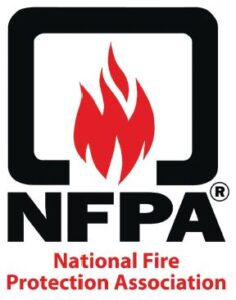Written on: May 1, 2024 by Nicholas Georges
As manufacturers and marketers of aerosol products know, there are many laws, regulations, standards and codes to comply with, such as ingredient disclosure, transportation regulations, and volatile organic compound (VOC) standards. Fire and building codes don’t immediately come to mind when discussing the most influential requirements, but these model codes, which are developed by the National Fire Protection Association (NFPA) and International Code Council (ICC), are adopted into law and enforced by Federal, State and local governments to regulate the construction and maintenance of buildings and control storage, use and handling of hazardous materials. In fact, they define all aspects of a building where aerosol products are manufactured, stored, sold or used, including building size, construction materials, exiting, sprinkler protection and ventilation. Aerosol product quantities, flammability classification, location in buildings, storage height, sprinkler protection and display layout are also detailed in building and fire codes.

Building and fire codes will be discussed at the upcoming ICC Committee Action Hearings for the next edition of the International Fire Code (IFC). Currently, there are three proposals to amend the fire codes for aerosol products in the IFC during this code cycle, two of which are from the Household & Commercial Products Association (HCPA) to align the IFC with recent amendments to the NFPA 30B, Code for the Manufacture & Storage of Aerosol Products. However, the third proposal, which was not introduced by Industry, is quite concerning.
Fire officials are proposing to amend a number of codes for a variety of products and materials within the IFC, including for aerosol products, to align with the Globally Harmonized System of Classification & Labeling of Chemicals (GHS) for flammability. Their rationale is that the Safety Data Sheet (SDS) is typically the only available information they have about flammability to verify the proper design of buildings and warehouses. While several industries have concerns about this kind of change, the aerosol products industry is uniquely positioned to argue against it.
The HCPA has been an active participant in the development of building and fire codes since the early 1980s. This involvement came about when the regulatory community attempted to severely restrict the storage and sales of aerosol products through draconian construction requirements and rigorous limits on the quantity of product in storage and sales after major fires caused by aerosols. To combat these requirements, the aerosol industry conducted numerous fire tests to develop a set of controls for the safe storage and sale of aerosol products. The HCPA has recommended many amendments to the U.S.’s complex system of fire and building codes, which are based on data developed from fire tests to ensure that HCPA’s positions are credible and compelling to fire officials, fire insurers and fire engineering professionals.
From this data, we know that alignment with GHS is not appropriate for aerosol products and, if adopted, would lead to inadequate fire protection systems. The amendments could also lead to confusion and would require significant retraining; it would also be costly to review and recategorize each aerosol product.
The aerosol industry would support amendments that are supported by data and show improved fire protection. How could Industry say no to these improvements? However, administrative changes that are not based on testing and that fundamentally change how fire protection is determined cannot—and should not—be accepted.
The HCPA is working on potential modifications to the proposed amendments that represent the aerosol industry’s best interests and we are hopeful to arrive at a common sense solution. However, if Industry’s interests are not considered, HCPA will object. Fire protection is important to everyone—we cannot go backward and Industry has data to demonstrate the most effective codes to be implemented.
For more information about fire and building codes for aerosol products, please contact me at ngeorges@thehcpa.org. SPRAY